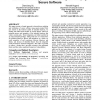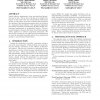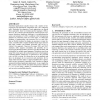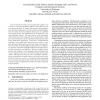106
Voted
KBSE
2005
IEEE
15 years 6 months ago
2005
IEEE
This paper presents a formal approach to threat-driven modeling and verification of secure software using aspect-oriented Petri nets. Based on the behavior model of intended funct...
86
Voted
KBSE
2005
IEEE
15 years 6 months ago
2005
IEEE
121
Voted
KBSE
2005
IEEE
15 years 6 months ago
2005
IEEE
Current formal software engineering methodologies provide a vast array of languages for specifying correctness properties, as well as a wide assortment automated tools that aid in...
120
Voted
KBSE
2005
IEEE
15 years 6 months ago
2005
IEEE
Engineering distributed systems is a challenging activity. This is partly due to the intrinsic complexity of distributed systems, and partly due to the practical obstacles that de...
97
Voted
KBSE
2005
IEEE
15 years 6 months ago
2005
IEEE
Localizing the cause(s) of an observable error lies at the heart of program debugging. Fault localization often proceeds by comparing the failing program run with some “successf...
84
Voted
KBSE
2005
IEEE
15 years 6 months ago
2005
IEEE
112
Voted
KBSE
2005
IEEE
15 years 6 months ago
2005
IEEE
We present a new model checking algorithm for verifying computation tree logic (CTL) properties. Our technique is based on using language inference to learn the fixpoints necessar...
90
Voted
KBSE
2005
IEEE
15 years 6 months ago
2005
IEEE
During software maintenance, some non-functional properties may be lost. This is due to the lack of an explicit definition of their links with the corresponding architectural choi...
131
Voted
KBSE
2005
IEEE
15 years 6 months ago
2005
IEEE
Distributed applications typically interact with a number of heterogeneous and autonomous components that evolve independently. Methodical development of such applications can ben...
124
click to vote
KBSE
2005
IEEE
15 years 6 months ago
2005
IEEE
User-session-based testing of web applications gathers user sessions to create and continually update test suites based on real user input in the field. To support this approach ...




